Published January 28, 2024
A Comparison Between IronPDF and PdfPig
1. Introduction
In software development, particularly within the .NET framework, the manipulation and management of PDF files is a critical task. C# is often the choice for such operations, necessitating reliable PDF libraries. Two such libraries, IronPDF and PdfPig, have emerged as prominent tools in this space.
IronPDF is famous for its high-performance capabilities in C# environments, offering extensive features ranging from HTML to PDF conversion, comprehensive formatting options, to advanced editing capabilities. It's tailored for .NET developers seeking a multifaceted approach to PDF manipulation. On the other hand, PdfPig, known for its adeptness in reading and extracting text and other content from PDFs, serves as a crucial tool for developers prioritizing content extraction and analysis.
2. IronPDF: C# PDF Library

IronPDF stands as a powerful and versatile PDF library within the C# PDF libraries. Designed specifically for .NET developers, it offers a comprehensive suite of features that enable the creation, manipulation, and conversion of PDF documents. Its functionality extends across various .NET versions, showcasing its adaptability in different development environments.
2.1 Key Features of IronPDF
2.1.1 HTML to PDF Conversion
IronPDF excels in converting HTML documents and web pages into PDF format, preserving the layout, styling, and content accurately. This feature is especially valuable for generating reports, invoices, and other documents from web-based applications.
2.1.2 Formatting PDFs
The library allows the use of HTML assets like HTML (5 and below), CSS (Screen & Print), JavaScript, and images in PDFs. It also supports applying page templates and settings, including headers, footers, page numbers, custom margins, responsive layouts, and paper size customization. You can also edit document metadata.
2.1.3 Editing PDFs
IronPDF offers functionalities to set properties and security and edit document structure and page content. This includes adding digital signatures, PDF file compression, editing metadata, merging and splitting PDFs, adding annotations, and creating or editing PDF forms.
2.1.4 Cross-Platform Support
IronPDF works across multiple platforms and supports a variety of programming languages and environments, including Windows, Linux, macOS, Docker, Azure, and AWS. It is compatible with Microsoft Visual Studio and JetBrains Rider & ReSharper.
3. Overview of PdfPig
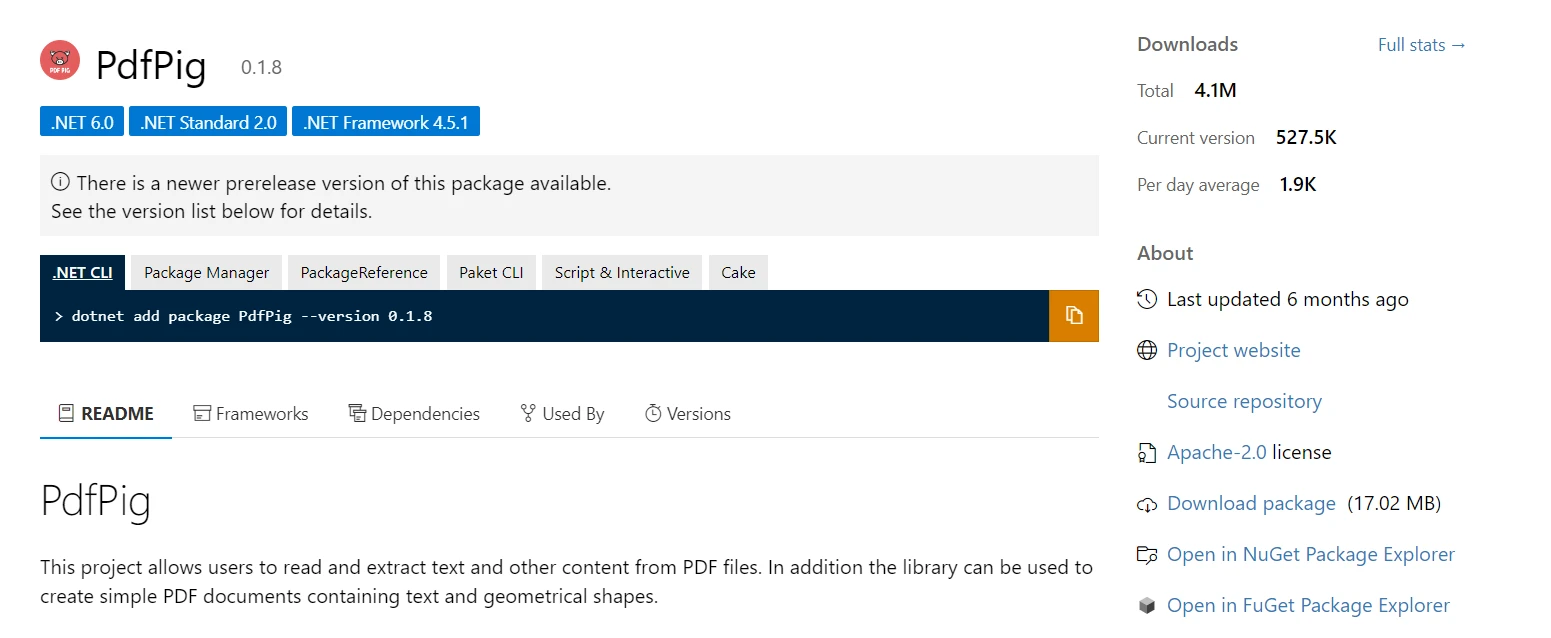
PdfPig is a C# library primarily focused on reading and extracting content from PDF files. It's a port of the popular PDFBox library and is tailored for the .NET platform. PDFPig's primary strength lies in its ability to dissect and analyze PDF documents, making it a valuable tool for developers who need to analyze and process the content of PDF files.
3.1 Key Features of PDFPig
3.1.1 Text and Content Extraction
PDFPig excels in extracting text, images, and other content from PDF documents. This capability is crucial for applications involving content analysis, data extraction, and document processing.
3.1.2 Layout Analysis
The library offers functionalities for understanding the layout of PDF pages. This includes identifying text blocks, which is beneficial for reconstructing the document's original layout or for extracting structured data.
3.1.3 Compatibility and Support
PDFPig is designed to work with various versions of the PDF specification. This compatibility makes it a versatile tool for handling a wide range of PDF documents.
4. Create a .NET Project: Building a Console Application
In this section, we'll walk through the steps to set up a basic console application, which can be a starting point for integrating and testing libraries like IronPDF and PDFPig.
4.1 Starting a New Project
To begin, launch Visual Studio. Once opened, initiate a new project by clicking on the "Create a New Project" button. This will lead you to a variety of project types.

For this guide, select the 'Console App' option. You may also choose ".NET Core App" or other relevant project types based on your specific needs.
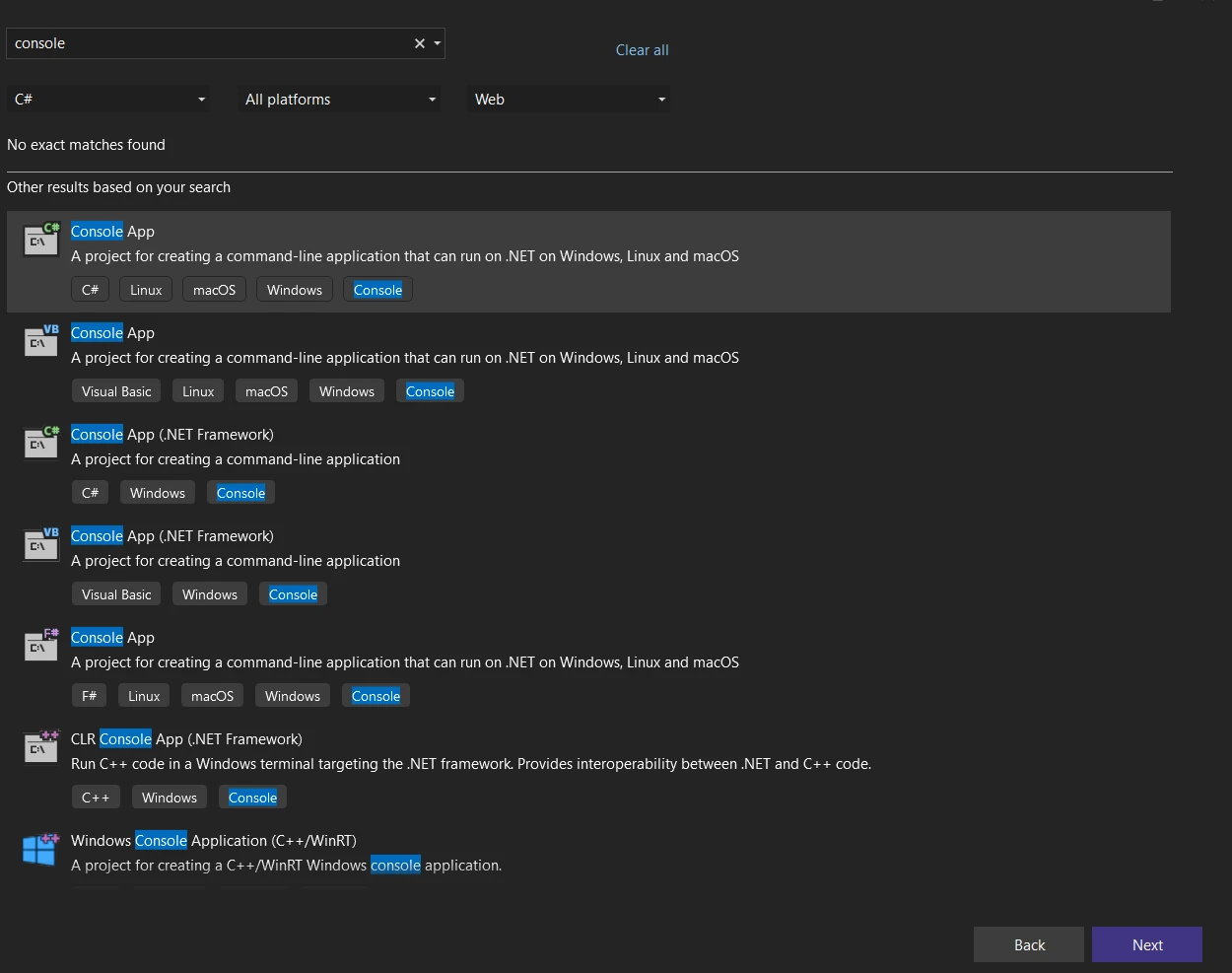
4.2 Setting Up the Project
With your project type selected, the next step involves naming your project. Locate the text box designated for the project name and enter a name that reflects the purpose of your application.
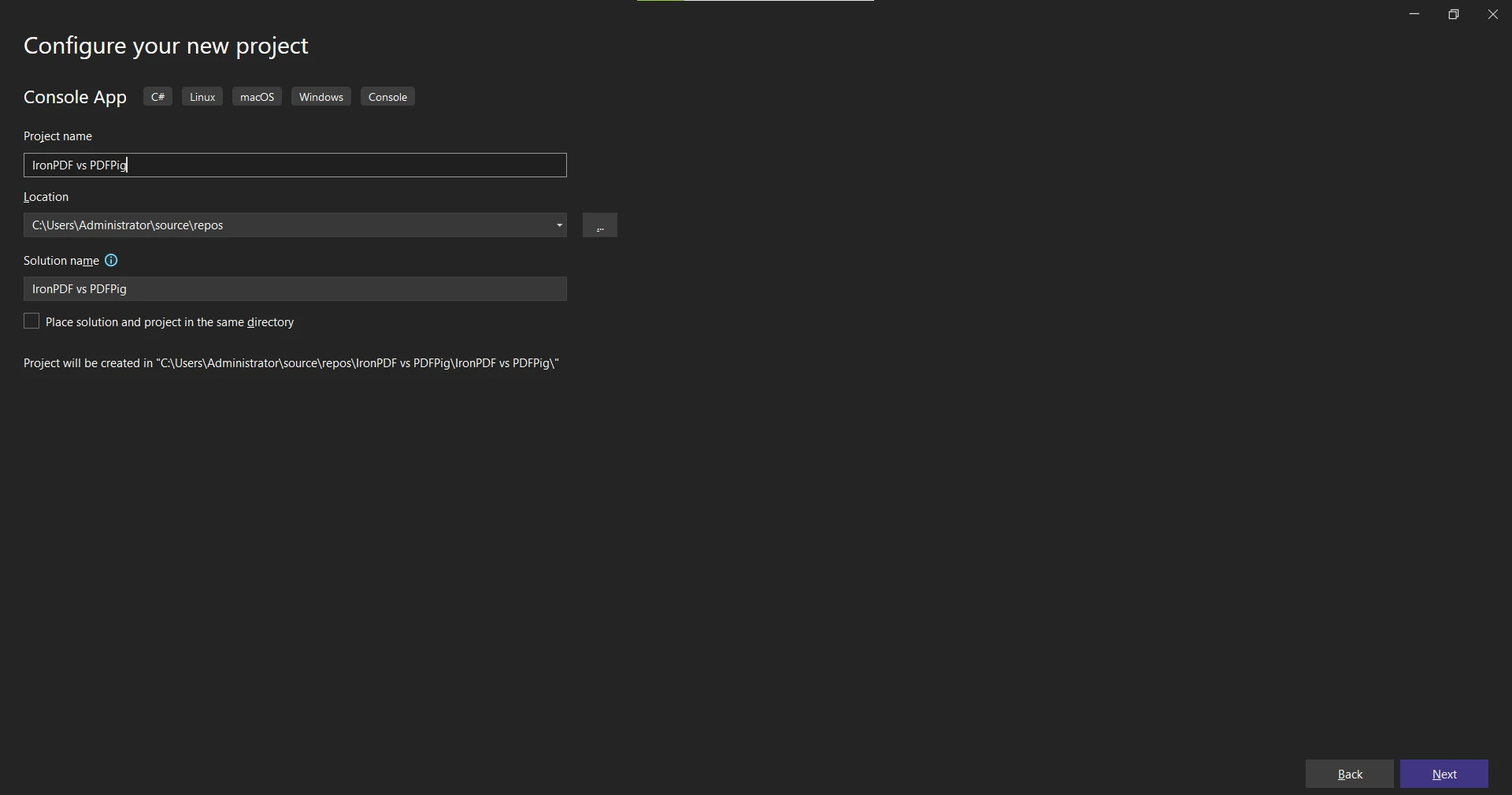
Once you've named your project and chosen its location, click on the 'Next' button to proceed.
4.3 Selecting .NET Framework
After setting up your project's basic details, you'll be prompted to select a .NET framework version. Select a .NET framework version that aligns with your project's requirements and the compatibility needs of the libraries you plan to use, such as IronPDF and PDFPig. After selecting the appropriate .NET framework version, click on the 'Create' button to finalize the creation of your new project.
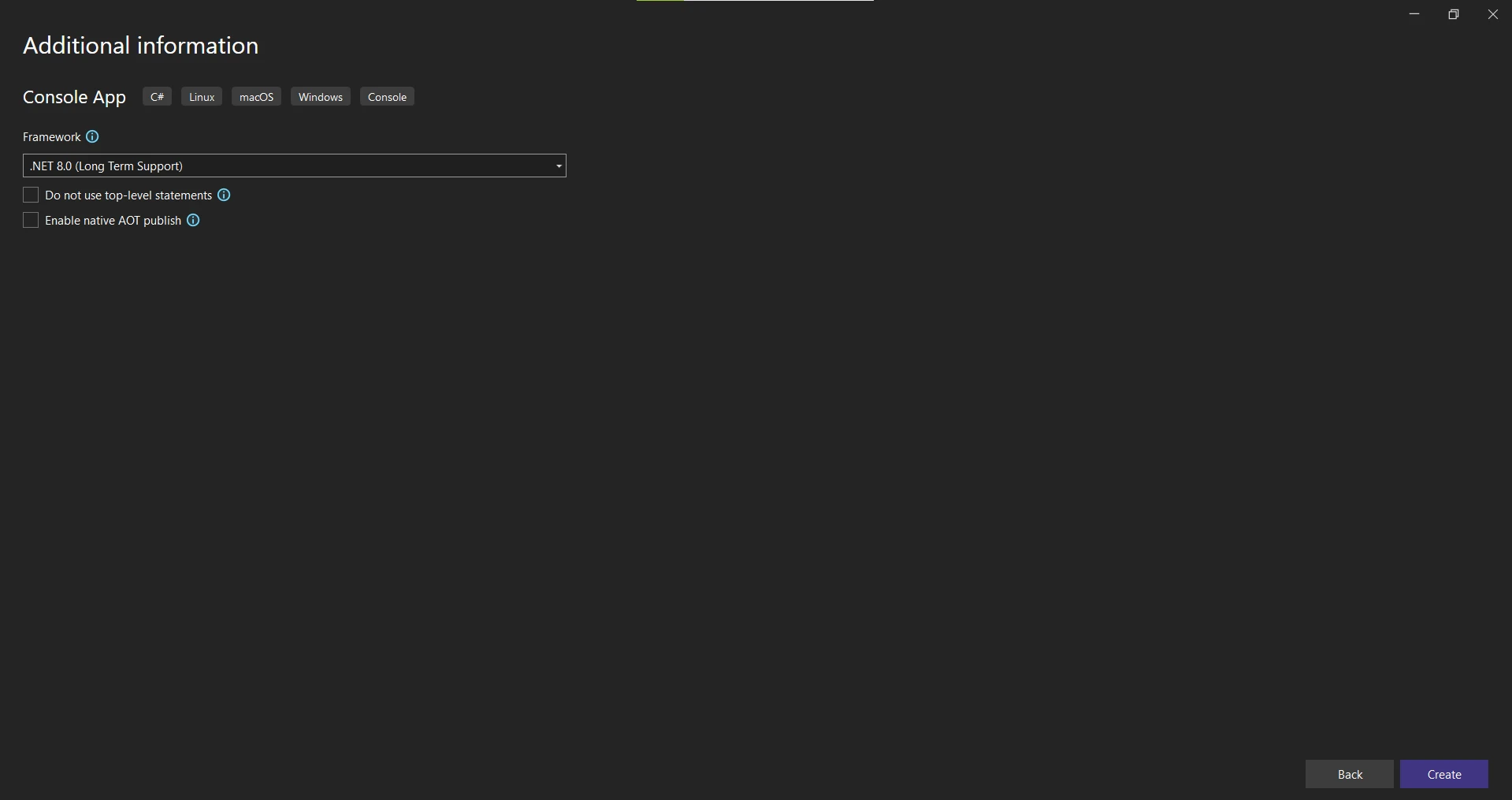
Your project is now set up and ready for further development, including the integration of the desired PDF libraries and the writing of your application's code.
5. Install IronPDF Library
5.1 Using the NuGet Package Manager
To incorporate IronPDF into your project via the Visual Studio NuGet Package Manager, follow these instructions:
- Begin by opening your project in Visual Studio.
-
Navigate to the "Tools" menu, select "NuGet Package Manager", then choose "Manage NuGet Packages for Solution".
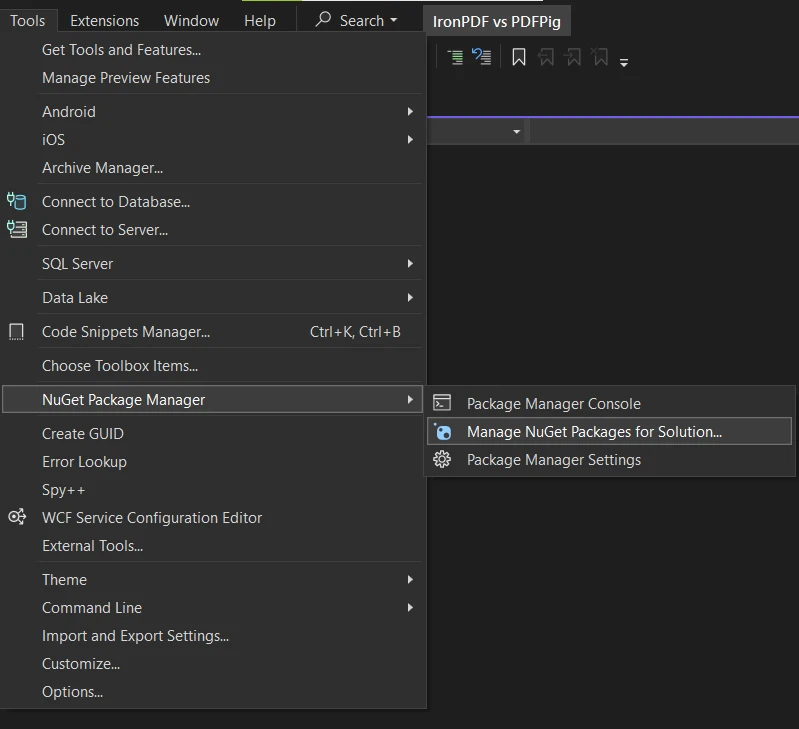
- In the NuGet Package Manager interface, click on the "Browse" tab.
- Type "IronPDF" into the search bar and look for the IronPDF package.
-
Once located, select the IronPDF package and click "Install."
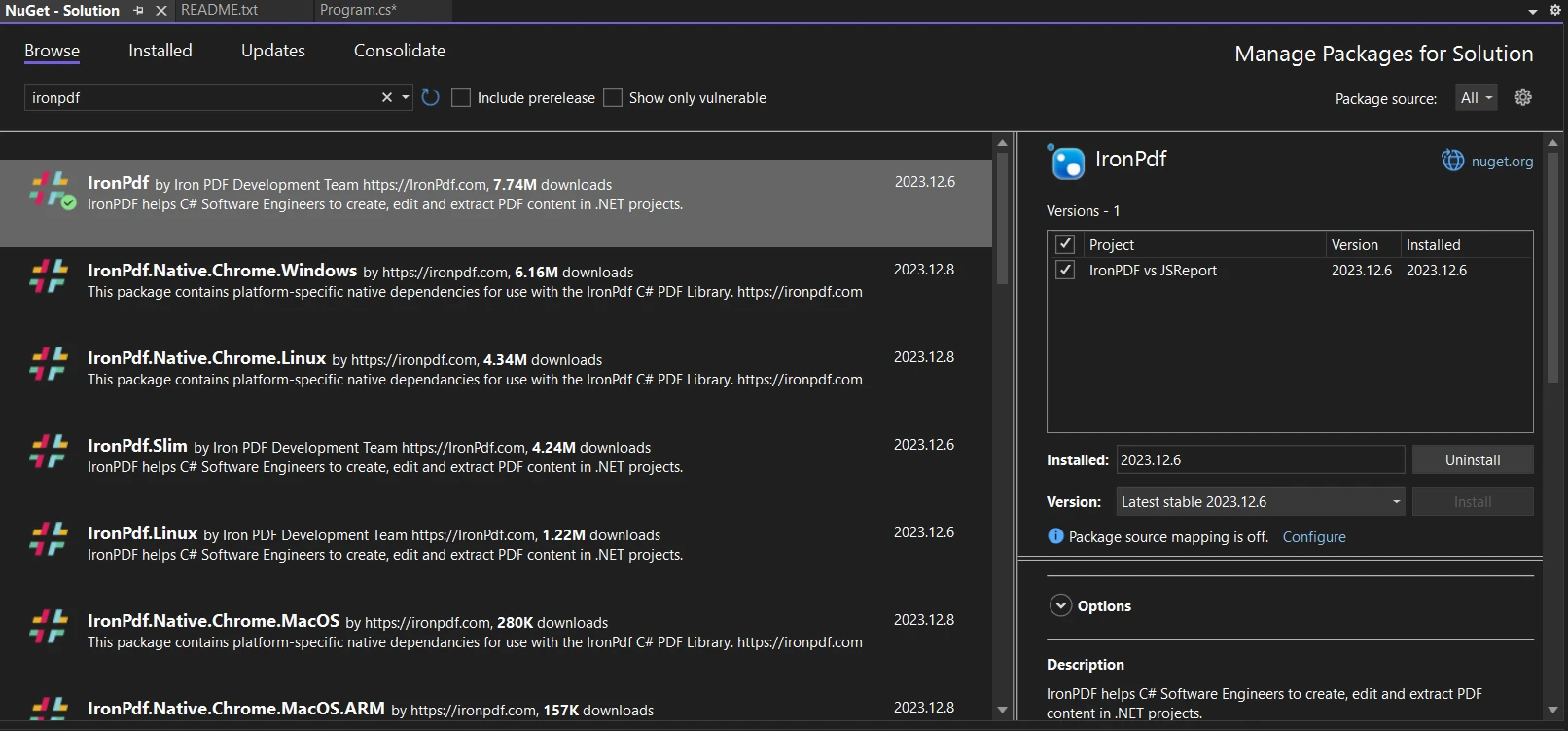
- Follow the on-screen instructions to complete the installation process.
5.2 Using the Visual Studio Command Line
For those who prefer command-line operations, IronPDF can be installed in Visual Studio as follows:
- Open your project in Visual Studio.
-
Go to the "Tools" menu, hover over "NuGet Package Manager," and select "Package Manager Console" from the submenu.
-
Within the console, type the command.
Install-Package IronPdf
- Press Enter to run the command. The installation will begin and complete automatically.
5.3 Direct Download from the NuGet Webpage
Alternatively, IronPDF can be obtained directly from the NuGet website:
- Visit the official NuGet website.
- Search for the IronPDF package using the site's search functionality.
-
On the IronPDF package page, locate the download options.
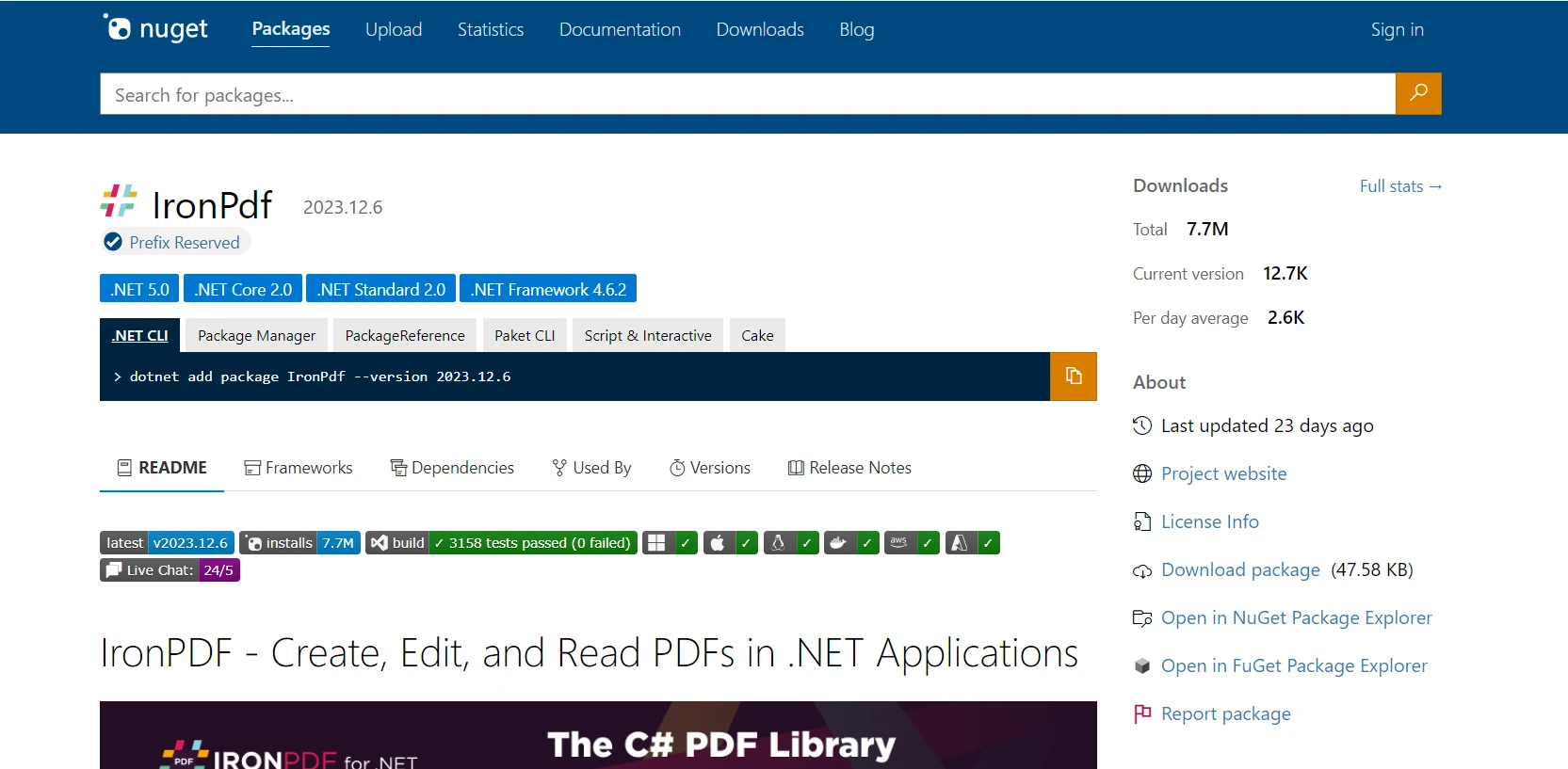
- Download the .nupkg file and manually integrate it into your project.
6. Install PdfPig
6.1 Using NuGet Package Manager in Visual Studio
To integrate PdfPig using the NuGet Package Manager in Visual Studio, follow these steps:
- Open your Visual Studio project.
-
Select ‘Tools’ from the menu, then ‘Manage NuGet Packages’ to open the NuGet Package Manager interface.
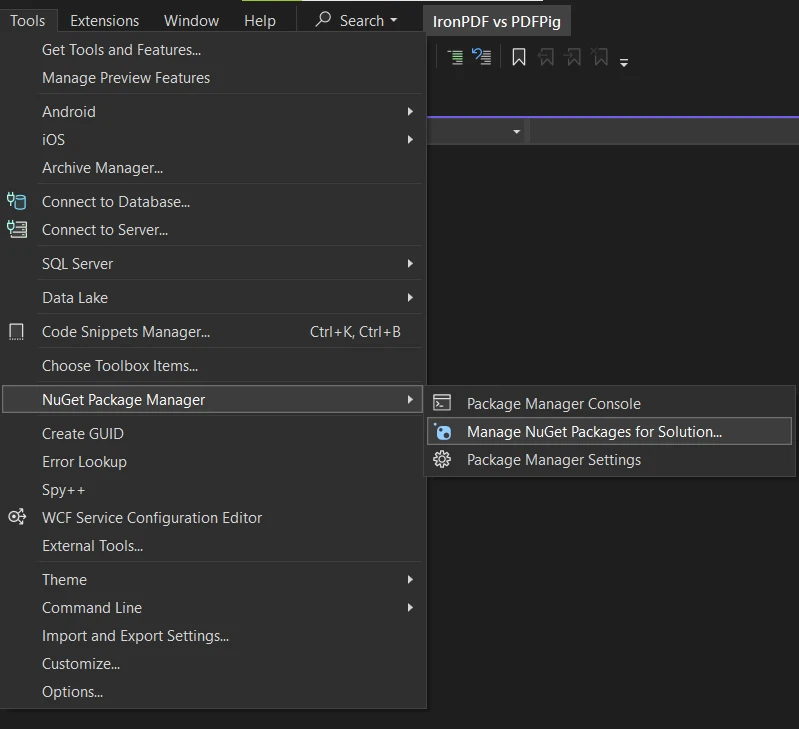
- In the NuGet Package Manager, search for "PdfPig."
-
Upon finding the PdfPig package, select it and click ‘Install’.
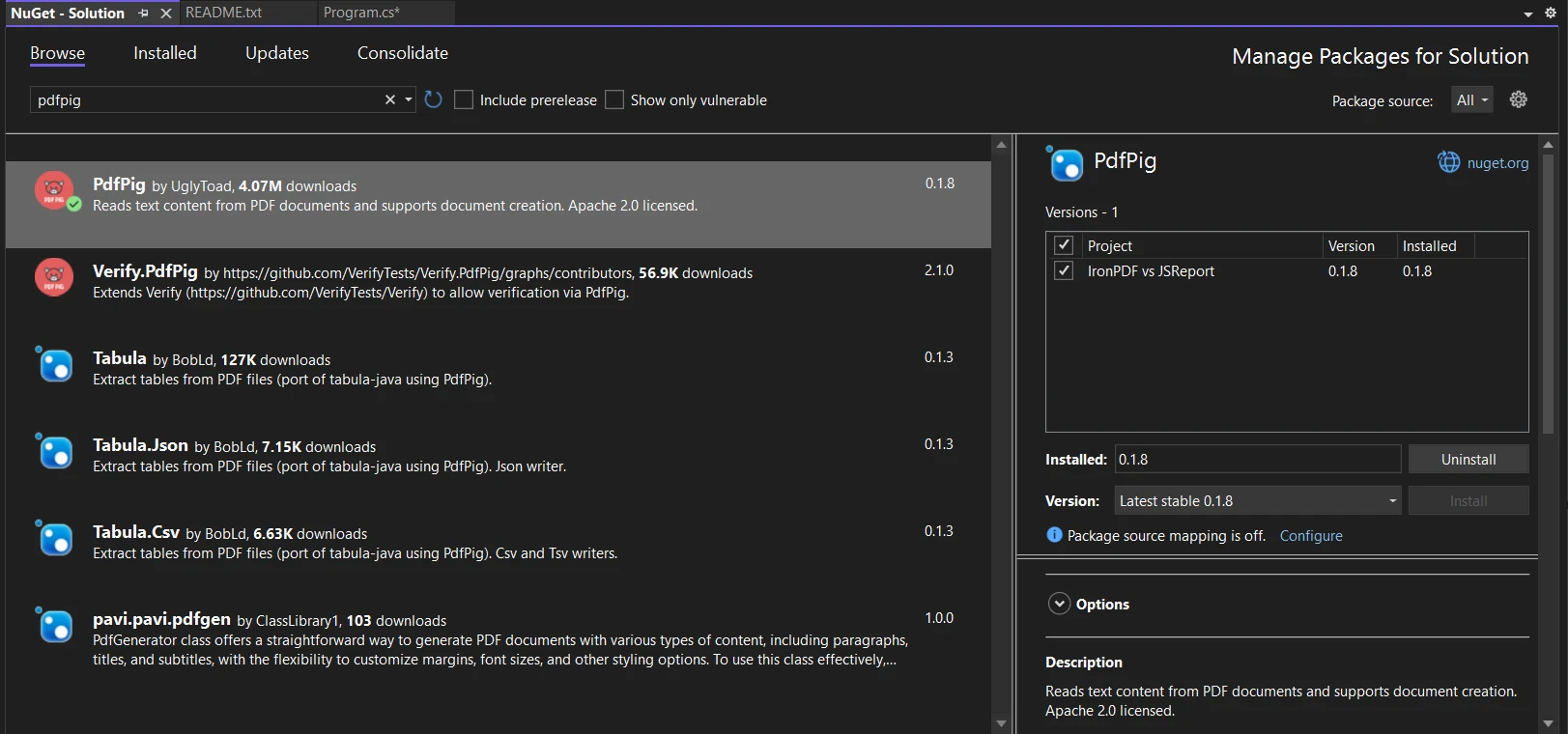
- Complete the installation by following the provided prompts.
6.2 Using NuGet Package Manager Console
For those who prefer using the console:
-
Access the NuGet Package Manager Console through the ‘Tools’ menu by selecting ‘NuGet Package Manager’ followed by ‘Package Manager Console’.
-
In the console, input the command:
Install-Package PdfPig
- Execute the command by pressing Enter and wait for the installation to finalize.
7. Comparison of Advanced Features in IronPDF and PDFPig
7.1 IronPDF's Advanced Features
IronPDF provides a robust set of advanced features and customization options that allow developers to tailor PDFs to their specific needs. These features range from document conversion to detailed manipulation and security enhancements, which are integral for creating professional and secure documents.
7.1.1 IronPDF's HTML to PDF Conversion
IronPDF excels in converting HTML content to PDF format, a feature highly valued in the .NET developer community for its effectiveness and ease of use. This library is known for its high performance and a range of advanced features that contribute to its ability to produce high-quality PDFs from HTML sources.
Several advanced features bolster IronPDF's proficiency in HTML to PDF conversion:
CSS Rendering: IronPDF accurately renders CSS styles, ensuring that the visual appearance of the HTML source is faithfully reproduced in the PDF output.
JavaScript Execution: It supports the execution of JavaScript within HTML, which is helpful for dynamic and interactive web content.
IronPDF offers three primary methods for converting HTML to PDF:
7.1.1.1 HTML String To PDF
IronPDF allows the conversion of HTML strings directly to PDF. This feature is particularly useful for dynamically generated HTML content or HTML content stored in string format within your application. It ensures that all HTML elements, including CSS and JavaScript, are rendered accurately in the final PDF.
using IronPdf;
IronPdf.License.LicenseKey = "Your-License-Key";
var renderer = new ChromePdfRenderer();
// Create a PDF from a HTML string using C#
var pdf = renderer.RenderHtmlAsPdf("<h1>Welcome to Our Report</h1><p>This document is generated using IronPDF in C#. It showcases how easy it is to convert HTML into a PDF document. Enjoy reading!</p>");
// Export to a file or Stream
pdf.SaveAs("c://HtmlToPdf.pdf");using IronPdf;
IronPdf.License.LicenseKey = "Your-License-Key";
var renderer = new ChromePdfRenderer();
// Create a PDF from a HTML string using C#
var pdf = renderer.RenderHtmlAsPdf("<h1>Welcome to Our Report</h1><p>This document is generated using IronPDF in C#. It showcases how easy it is to convert HTML into a PDF document. Enjoy reading!</p>");
// Export to a file or Stream
pdf.SaveAs("c://HtmlToPdf.pdf");Imports IronPdf
IronPdf.License.LicenseKey = "Your-License-Key"
Dim renderer = New ChromePdfRenderer()
' Create a PDF from a HTML string using C#
Dim pdf = renderer.RenderHtmlAsPdf("<h1>Welcome to Our Report</h1><p>This document is generated using IronPDF in C#. It showcases how easy it is to convert HTML into a PDF document. Enjoy reading!</p>")
' Export to a file or Stream
pdf.SaveAs("c://HtmlToPdf.pdf")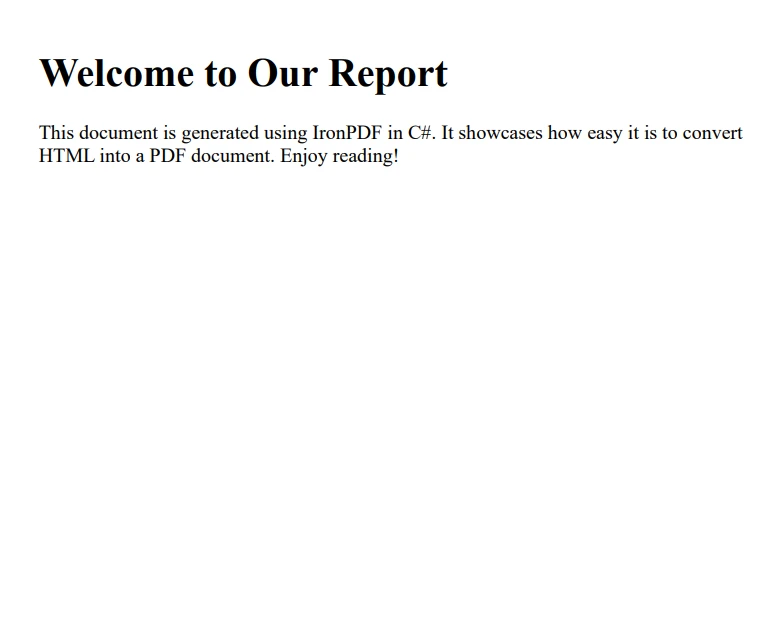
7.1.1.2 HTML Files to PDF
This functionality enables the conversion of static HTML files to PDF documents. It's ideal for static HTML files or templates that are periodically updated and need to be converted into a consistent PDF format.
using IronPdf;
IronPdf.License.LicenseKey = "Your-License-Key";
var renderer = new ChromePdfRenderer();
renderer.RenderingOptions.PaperSize = IronPdf.Rendering.PdfPaperSize.A2;
// Create a PDF from a HTML File using C#
var pdf = renderer.RenderHtmlFileAsPdf("index.html");
// Export to a file or Stream
pdf.SaveAs("c://Invoice.pdf");using IronPdf;
IronPdf.License.LicenseKey = "Your-License-Key";
var renderer = new ChromePdfRenderer();
renderer.RenderingOptions.PaperSize = IronPdf.Rendering.PdfPaperSize.A2;
// Create a PDF from a HTML File using C#
var pdf = renderer.RenderHtmlFileAsPdf("index.html");
// Export to a file or Stream
pdf.SaveAs("c://Invoice.pdf");Imports IronPdf
IronPdf.License.LicenseKey = "Your-License-Key"
Dim renderer = New ChromePdfRenderer()
renderer.RenderingOptions.PaperSize = IronPdf.Rendering.PdfPaperSize.A2
' Create a PDF from a HTML File using C#
Dim pdf = renderer.RenderHtmlFileAsPdf("index.html")
' Export to a file or Stream
pdf.SaveAs("c://Invoice.pdf")OUTPUT
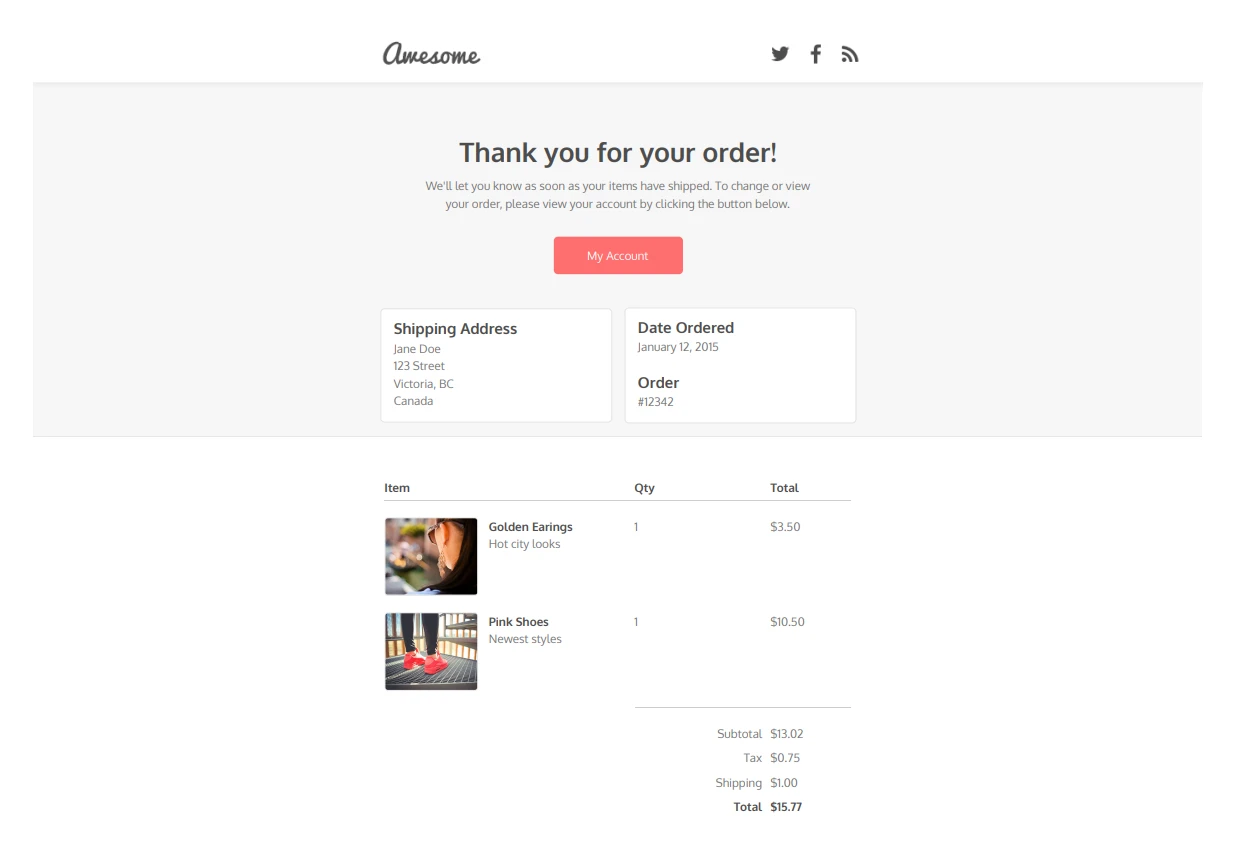
7.1.1.3 URL to PDF
IronPDF’s URL to PDF conversion allows for direct conversion of live web pages to PDF by providing the URL of the web page. This includes rendering all web page elements, such as HTML, CSS, and JavaScript, in their current state on the web.
using IronPdf;
IronPdf.License.LicenseKey = "Your-License-Key";
var renderer = new ChromePdfRenderer();
renderer.RenderingOptions.PaperSize = IronPdf.Rendering.PdfPaperSize.A2;
// Create a PDF from a HTML string using C#
var pdf = renderer.RenderUrlAsPdf("https://en.wikipedia.org/wiki/PDF");
// Export to a file or Stream
pdf.SaveAs("c://UrlToPdf.pdf");using IronPdf;
IronPdf.License.LicenseKey = "Your-License-Key";
var renderer = new ChromePdfRenderer();
renderer.RenderingOptions.PaperSize = IronPdf.Rendering.PdfPaperSize.A2;
// Create a PDF from a HTML string using C#
var pdf = renderer.RenderUrlAsPdf("https://en.wikipedia.org/wiki/PDF");
// Export to a file or Stream
pdf.SaveAs("c://UrlToPdf.pdf");Imports IronPdf
IronPdf.License.LicenseKey = "Your-License-Key"
Dim renderer = New ChromePdfRenderer()
renderer.RenderingOptions.PaperSize = IronPdf.Rendering.PdfPaperSize.A2
' Create a PDF from a HTML string using C#
Dim pdf = renderer.RenderUrlAsPdf("https://en.wikipedia.org/wiki/PDF")
' Export to a file or Stream
pdf.SaveAs("c://UrlToPdf.pdf")OUTPUT PDF file
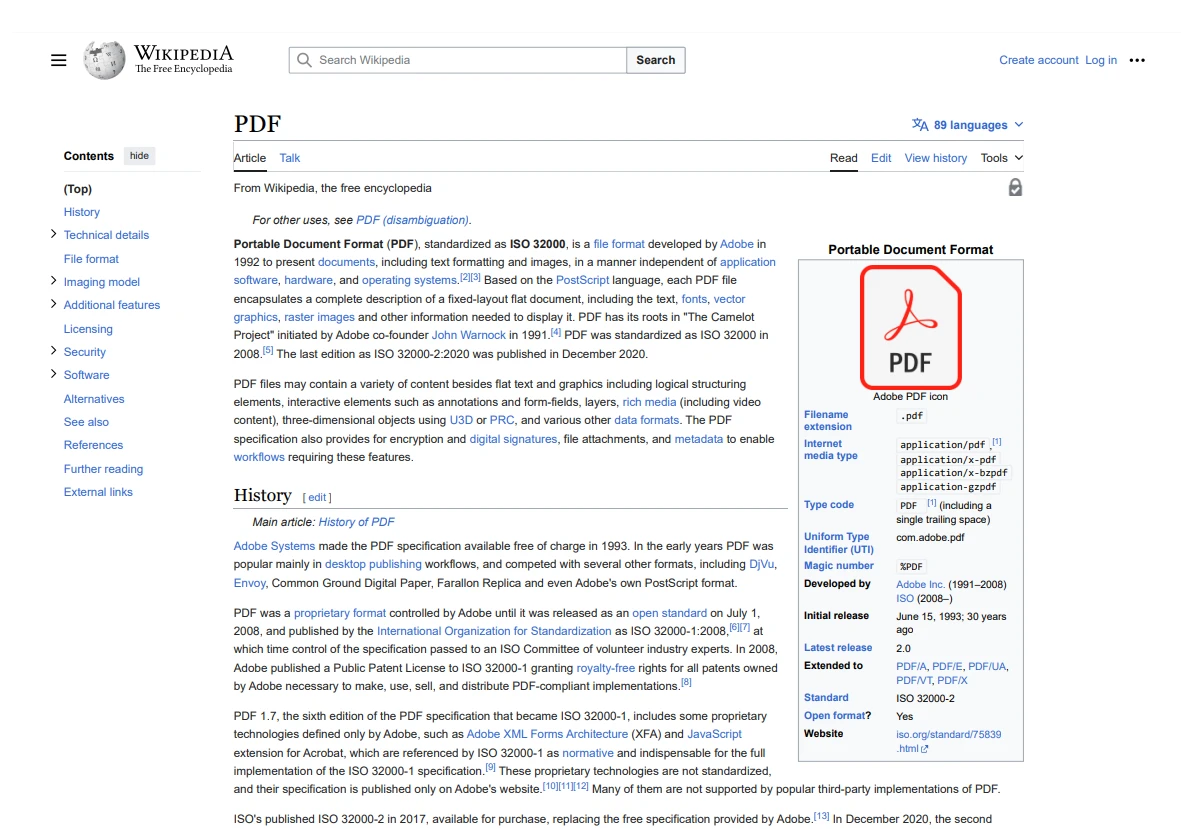
7.1.2 Images to PDF
IronPDF supports the direct conversion of images to PDF. This functionality is beneficial for preserving the visual integrity of documents when transitioning from image formats like JPG, PNG, or TIFF to a more versatile and widely accepted PDF format. This feature is particularly useful for compiling scanned documents, photos, or graphics into a single PDF file, which can then be shared or archived with ease.
7.1.3 Convert a PDF to Images
IronPDF allows the extraction of pages from PDF documents as images. This can be particularly useful when you need to create thumbnails for a document preview on a web page or for extracting high-quality images embedded in PDFs for separate use. Each page is rendered as an individual image, which can then be used in various applications.
using IronPdf;
IronPdf.License.LicenseKey = "Your-License-Key";
var pdf = PdfDocument.FromFile("c://invoice.pdf");
// Extract all pages to a folder as image files
pdf.RasterizeToImageFiles(@"C:\image\folder\*.png");
// Dimensions and page ranges may be specified
pdf.RasterizeToImageFiles(@"C:\image\folder\example_pdf_image_*.jpg", 100, 80);
// Extract all pages as AnyBitmap objects
AnyBitmap[] pdfBitmaps = pdf.ToBitmap();using IronPdf;
IronPdf.License.LicenseKey = "Your-License-Key";
var pdf = PdfDocument.FromFile("c://invoice.pdf");
// Extract all pages to a folder as image files
pdf.RasterizeToImageFiles(@"C:\image\folder\*.png");
// Dimensions and page ranges may be specified
pdf.RasterizeToImageFiles(@"C:\image\folder\example_pdf_image_*.jpg", 100, 80);
// Extract all pages as AnyBitmap objects
AnyBitmap[] pdfBitmaps = pdf.ToBitmap();Imports IronPdf
IronPdf.License.LicenseKey = "Your-License-Key"
Dim pdf = PdfDocument.FromFile("c://invoice.pdf")
' Extract all pages to a folder as image files
pdf.RasterizeToImageFiles("C:\image\folder\*.png")
' Dimensions and page ranges may be specified
pdf.RasterizeToImageFiles("C:\image\folder\example_pdf_image_*.jpg", 100, 80)
' Extract all pages as AnyBitmap objects
Dim pdfBitmaps() As AnyBitmap = pdf.ToBitmap()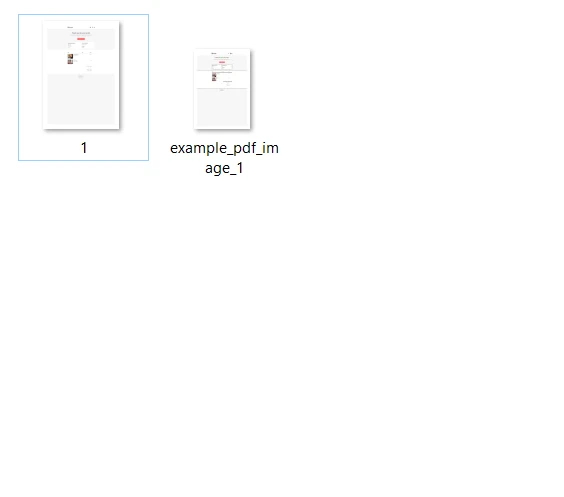
7.1.4 DOCX to PDF
The DOCX to PDF conversion feature of IronPDF ensures that Word documents are seamlessly converted into PDF format, retaining all the rich formatting and content from the original document. This feature is crucial for creating final versions of documents that are ready for distribution or publication, as PDFs are widely used for their consistent display across different platforms.
using IronPdf;
IronPdf.License.LicenseKey = "Your-License-Key";
// Instantiate Renderer
DocxToPdfRenderer renderer = new DocxToPdfRenderer();
// Render from DOCX file
PdfDocument pdf = renderer.RenderDocxAsPdf("invoice.docx");
// Save the PDF
pdf.SaveAs("invoice.pdf");using IronPdf;
IronPdf.License.LicenseKey = "Your-License-Key";
// Instantiate Renderer
DocxToPdfRenderer renderer = new DocxToPdfRenderer();
// Render from DOCX file
PdfDocument pdf = renderer.RenderDocxAsPdf("invoice.docx");
// Save the PDF
pdf.SaveAs("invoice.pdf");Imports IronPdf
IronPdf.License.LicenseKey = "Your-License-Key"
' Instantiate Renderer
Dim renderer As New DocxToPdfRenderer()
' Render from DOCX file
Dim pdf As PdfDocument = renderer.RenderDocxAsPdf("invoice.docx")
' Save the PDF
pdf.SaveAs("invoice.pdf")7.1.5 Adding HTML Headers and Footers
IronPDF's ability to add HTML content as headers and footers in a PDF document enhances the customizability of the output. This means you can include dynamic links, stylized texts, or images in the header and footer sections of a PDF. This is ideal for branding, adding relevant navigation links, or providing contact information in a professional format.
7.1.6. Page Numbers and Page Breaks
Inserting page numbers and managing page breaks are important for document readability and navigation. IronPDF provides the tools to programmatically add page numbers in various styles and formats, as well as control where page breaks occur, which is particularly useful in reports, contracts, and multi-section documents.
7.1.7 Custom Margins
Custom margin settings in IronPDF allow developers to define the precise layout of the PDF page. This control over margins is important when adhering to specific formatting requirements, such as for legal documents or academic papers, where margin guidelines may need to be met accurately.
using IronPdf;
IronPdf.License.LicenseKey = "Your-License-Key";
var renderer = new ChromePdfRenderer();
// Set Margins (in millimeters)
renderer.RenderingOptions.MarginTop = 40;
renderer.RenderingOptions.MarginLeft = 20;
renderer.RenderingOptions.MarginRight = 20;
renderer.RenderingOptions.MarginBottom = 40;
renderer.RenderHtmlFileAsPdf("invoice").SaveAs("my-content.pdf");using IronPdf;
IronPdf.License.LicenseKey = "Your-License-Key";
var renderer = new ChromePdfRenderer();
// Set Margins (in millimeters)
renderer.RenderingOptions.MarginTop = 40;
renderer.RenderingOptions.MarginLeft = 20;
renderer.RenderingOptions.MarginRight = 20;
renderer.RenderingOptions.MarginBottom = 40;
renderer.RenderHtmlFileAsPdf("invoice").SaveAs("my-content.pdf");Imports IronPdf
IronPdf.License.LicenseKey = "Your-License-Key"
Dim renderer = New ChromePdfRenderer()
' Set Margins (in millimeters)
renderer.RenderingOptions.MarginTop = 40
renderer.RenderingOptions.MarginLeft = 20
renderer.RenderingOptions.MarginRight = 20
renderer.RenderingOptions.MarginBottom = 40
renderer.RenderHtmlFileAsPdf("invoice").SaveAs("my-content.pdf")7.1.8 PDF Encryption & Decryption
Security is a paramount concern, and IronPDF addresses this by offering PDF encryption and decryption capabilities. Encrypting a PDF restricts unauthorized access, protecting sensitive information. The decryption feature is equally important when there's a need to remove restrictions for editing or printing, provided the appropriate permissions are granted.
7.1.9 Digital Signatures
Digital signatures add a layer of verification and authenticity to a document. IronPDF supports digital signing, which is an essential feature for legal documents, contracts, and any official communication that requires confirmation of identity and intent.
7.1.10 PDF Compression
PDF compression is a vital feature provided by IronPDF that helps reduce the file size of documents, facilitating easier sharing and storage. This feature is especially useful when dealing with large documents that contain high-resolution images or extensive data, ensuring that the document is more manageable without compromising the quality.
using IronPdf;
var pdf = new PdfDocument("doc.pdf");
// Quality parameter can be 1-100, where 100 is 100% of original quality
pdf.CompressImages(60);
pdf.SaveAs("compressed_doc.pdf");using IronPdf;
var pdf = new PdfDocument("doc.pdf");
// Quality parameter can be 1-100, where 100 is 100% of original quality
pdf.CompressImages(60);
pdf.SaveAs("compressed_doc.pdf");Imports IronPdf
Private pdf = New PdfDocument("doc.pdf")
' Quality parameter can be 1-100, where 100 is 100% of original quality
pdf.CompressImages(60)
pdf.SaveAs("compressed_doc.pdf")7.2 PdfPig Advanced Features
PdfPig is a library that excels in reading and analyzing PDF documents. While it doesn't offer a broad suite of features for creating or manipulating PDFs like IronPDF, PdfPig does have advanced capabilities for extracting text and other content with precision and efficiency.
7.2.1 Advanced Text Analysis
PdfPig can handle complex text layouts, including columns and tables, and is capable of extracting text in the correct reading order. This is essential for data processing or when converting PDF content into other formats for text analysis.
using UglyToad.PdfPig;
using System;
class Program
{
static void Main()
{
using (var pdf = PdfDocument.Open("path/to/pdf"))
{
foreach (var page in pdf.GetPages())
{
foreach (var letter in page.Letters)
{
Console.WriteLine($"Text: {letter.Value}, Location: {letter.Location}");
}
}
}
}
}using UglyToad.PdfPig;
using System;
class Program
{
static void Main()
{
using (var pdf = PdfDocument.Open("path/to/pdf"))
{
foreach (var page in pdf.GetPages())
{
foreach (var letter in page.Letters)
{
Console.WriteLine($"Text: {letter.Value}, Location: {letter.Location}");
}
}
}
}
}Imports UglyToad.PdfPig
Imports System
Friend Class Program
Shared Sub Main()
Using pdf = PdfDocument.Open("path/to/pdf")
For Each page In pdf.GetPages()
For Each letter In page.Letters
Console.WriteLine($"Text: {letter.Value}, Location: {letter.Location}")
Next letter
Next page
End Using
End Sub
End Class7.2.2 Image and Path Extraction
PdfPig can extract images and vector paths from PDFs, which can be used for asset retrieval, document analysis, and archiving.
using UglyToad.PdfPig;
using UglyToad.PdfPig.Content;
using System;
using System.IO;
using System.Drawing;
class Program
{
static void Main()
{
using (var pdf = PdfDocument.Open("example.pdf"))
{
foreach (var page in pdf.GetPages())
{
var images = page.GetImages();
foreach (var image in images)
{
using (var img = Image.FromStream(new MemoryStream(image.Bytes)))
{
img.Save($"extracted_image_{page.Number}.png");
}
}
}
}
}
}using UglyToad.PdfPig;
using UglyToad.PdfPig.Content;
using System;
using System.IO;
using System.Drawing;
class Program
{
static void Main()
{
using (var pdf = PdfDocument.Open("example.pdf"))
{
foreach (var page in pdf.GetPages())
{
var images = page.GetImages();
foreach (var image in images)
{
using (var img = Image.FromStream(new MemoryStream(image.Bytes)))
{
img.Save($"extracted_image_{page.Number}.png");
}
}
}
}
}
}Imports UglyToad.PdfPig
Imports UglyToad.PdfPig.Content
Imports System
Imports System.IO
Imports System.Drawing
Friend Class Program
Shared Sub Main()
Using pdf = PdfDocument.Open("example.pdf")
For Each page In pdf.GetPages()
Dim images = page.GetImages()
For Each image In images
Using img = System.Drawing.Image.FromStream(New MemoryStream(image.Bytes))
img.Save($"extracted_image_{page.Number}.png")
End Using
Next image
Next page
End Using
End Sub
End Class7.2.3 Data Extraction
With PdfPig, it's possible to retrieve not just the content but also the metadata of a PDF, which includes information like the author, creation date, and custom properties embedded in the document.
using System;
using UglyToad.PdfPig;
using UglyToad.PdfPig.Content;
// Open the PDF document
using (PdfDocument document = PdfDocument.Open(pdfPath))
{
// Iterate through each page of the PDF
foreach (Page page in document.GetPages())
{
// Extract text from the current page
string text = page.Text;
// Output the text to the console
Console.WriteLine(text);
}
}
// Wait for user input to close the program
Console.WriteLine("Press any key to exit...");
Console.ReadKey();using System;
using UglyToad.PdfPig;
using UglyToad.PdfPig.Content;
// Open the PDF document
using (PdfDocument document = PdfDocument.Open(pdfPath))
{
// Iterate through each page of the PDF
foreach (Page page in document.GetPages())
{
// Extract text from the current page
string text = page.Text;
// Output the text to the console
Console.WriteLine(text);
}
}
// Wait for user input to close the program
Console.WriteLine("Press any key to exit...");
Console.ReadKey();Imports System
Imports UglyToad.PdfPig
Imports UglyToad.PdfPig.Content
' Open the PDF document
Using document As PdfDocument = PdfDocument.Open(pdfPath)
' Iterate through each page of the PDF
For Each page As Page In document.GetPages()
' Extract text from the current page
Dim text As String = page.Text
' Output the text to the console
Console.WriteLine(text)
Next page
End Using
' Wait for user input to close the program
Console.WriteLine("Press any key to exit...")
Console.ReadKey()Here is the extracted text:
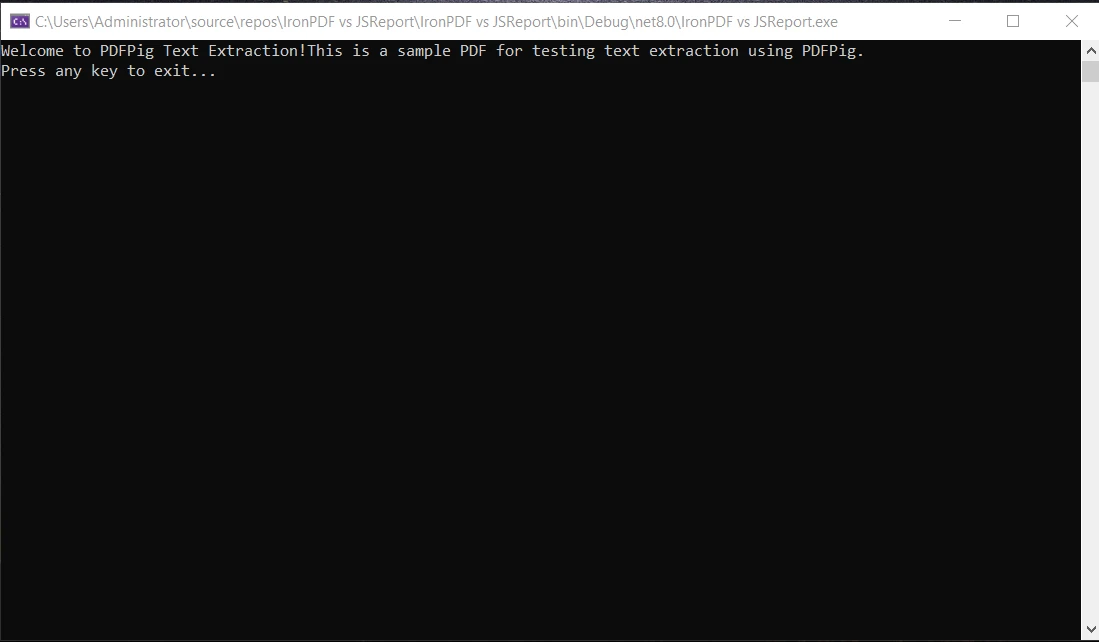
7.2.4 Extracting Metadata
Retrieving metadata involves accessing the internal information embedded within a PDF document, such as the title, author, and subject. This feature of PDFPig is useful for categorizing, organizing, and understanding the contextual background of PDF files.
using UglyToad.PdfPig;
using System;
class Program
{
static void Main()
{
using (var pdf = PdfDocument.Open("example.pdf"))
{
var info = pdf.Information;
Console.WriteLine($"Title: {info.Title}");
Console.WriteLine($"Author: {info.Author}");
Console.WriteLine($"Subject: {info.Subject}");
}
}
}using UglyToad.PdfPig;
using System;
class Program
{
static void Main()
{
using (var pdf = PdfDocument.Open("example.pdf"))
{
var info = pdf.Information;
Console.WriteLine($"Title: {info.Title}");
Console.WriteLine($"Author: {info.Author}");
Console.WriteLine($"Subject: {info.Subject}");
}
}
}Imports UglyToad.PdfPig
Imports System
Friend Class Program
Shared Sub Main()
Using pdf = PdfDocument.Open("example.pdf")
Dim info = pdf.Information
Console.WriteLine($"Title: {info.Title}")
Console.WriteLine($"Author: {info.Author}")
Console.WriteLine($"Subject: {info.Subject}")
End Using
End Sub
End Class7.2.5 PDFPig's HTML to PDF Conversion
PDFPig cannot convert HTML to PDF. It is a library specifically designed for extracting and analyzing content from existing PDF files rather than creating or converting documents. PDFPig excels in reading PDFs, extracting text, analyzing document layout, and extracting other content like images.
8. Documentation and Support
8.1 IronPDF Documentation and Support
IronPDF offers extensive documentation and support to assist developers in implementing and utilizing its features effectively. The documentation includes a comprehensive guide on getting started, a features overview, quick-start examples, and detailed object references.
In terms of support, IronPDF provides technical support 24 hours a day, 5 days a week, with engineers available to assist with any issues that may arise. The support team is responsive and dedicated to continually improving IronPDF with new releases. They encourage users to submit bug reports and provide feedback to enhance the library further. Regular updates are published, sometimes more than once a month, ensuring that the library remains up-to-date with the latest features and fixes.
8.2 PdfPig Documentation and Support
PdfPig, being an open-source library, relies on community-driven documentation and support. While it may not offer the same level of dedicated technical support as a commercial product like IronPDF, there are resources available where developers can seek assistance and documentation. This typically includes GitHub repositories, community forums, or platforms like Stack Overflow where developers can share knowledge and solutions.
9. Licensing Models
9.1 IronPDF's License
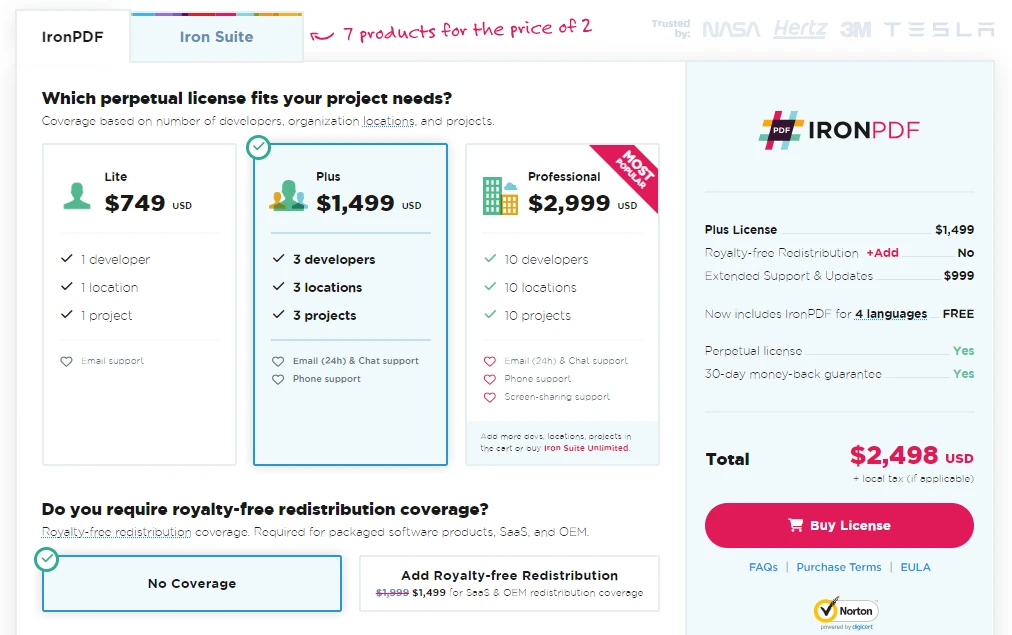
IronPDF's pricing structure offers three main editions, each with a one-time fee and varying levels of features suitable for different project scales:
- Lite Edition: Priced at $749, this edition is geared towards smaller projects and individual developers.
- Professional Edition: Available for $1499, offering more extensive features for professional developers.
- Unlimited Edition: The most comprehensive package, with a price tag of $2999, is designed for large-scale enterprise projects that require unlimited usage.
These prices reflect a one-time fee for perpetual licenses, which come with one year of support and updates. Additional extended support and updates can be purchased separately. IronPDF offers a free trial, which allows developers to evaluate its features and capabilities. During the trial period, you can use the library without any cost to assess whether it meets your project's requirements before committing to a purchase.
For the most up-to-date pricing and to confirm the details of what each edition includes, you should visit the official IronPDF pricing page.
9.2 PdfPig License
PdfPig is an open-source project licensed under the MIT License. This is a permissive license that allows for reuse within proprietary software as long as the license and copyright notice are included with any substantial portions of the software. The MIT License does not impose many restrictions on the use or distribution of the software, making it a flexible choice for developers and companies to integrate into their projects.
Conclusion
In comparing IronPDF and PdfPig, we've dissected a range of factors, from their core functionalities to their advanced features, performance, documentation, support, and licensing models.
IronPDF stands out for its comprehensive set of features for creating and editing PDFs directly from HTML, images, and text, as well as its ability to add advanced functionality like encryption, digital signatures, and custom headers/footers. It caters to a variety of developer needs with its tiered licensing, offering options from small-scale projects to enterprise-level deployments. The commercial nature of IronPDF is reflected in its structured support and extensive documentation, making it a reliable choice for critical applications where ongoing support and regular updates are necessary.
PdfPig, on the other hand, is a specialized tool focused on extracting text and other content from PDFs. It is distinguished by its MIT license, allowing great flexibility for developers to use and integrate it into their applications, including commercial projects, without incurring additional costs. While it may not offer the same level of documentation and direct support as IronPDF, its open-source community provides a platform for collaboration and assistance.
Choosing between IronPDF and PDFPig will depend on the specific needs of your project. If you require robust PDF creation and editing capabilities with commercial support, IronPDF is the appropriate choice. However, if your primary need is to extract and analyze PDF content, and you prefer an open-source solution, PDFPig is an excellent option.











